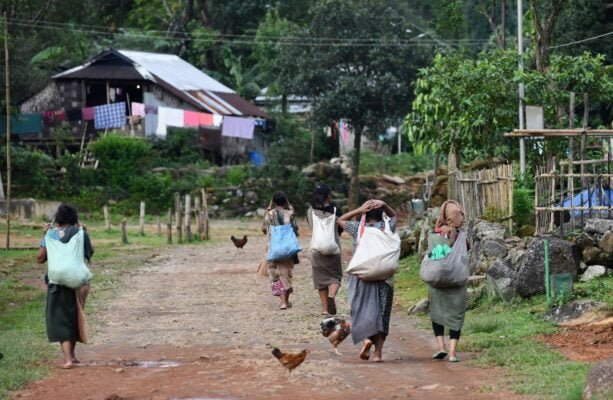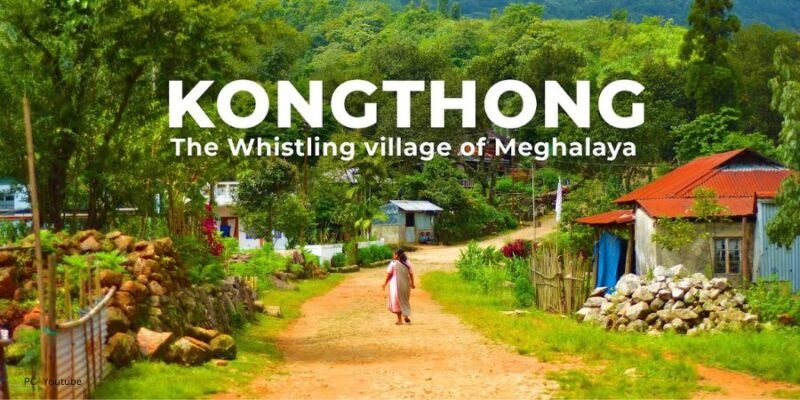If you find your way over the steep roads into the steep hills of Meghalaya, different tunes will reach your ears from the lush subtropical woods. Travelling down the hazardous turn of these east indian mountains you’ll come across various sounds sung in melodic tune-like forms. these will be any native song, these are the sound of one individual calling another. As you’ll reach the Kongthong village, you’ll be accompanied by additional tunes floating in the air since one villager cried out to another.
Kongthong village is located in the Meghalayan state of east India, nestled among the beautiful East Khasi Hills. This village is only a 3-hour drive from Shillong, the state capital. The community is surrounded by gorgeous high peaks and dizzyingly deep canyons, and civilisation is scarce in these sections. But what’s with people singing names?
Indian Culture – Kongthong Village
The Kongthong village hosts a unique custom of Indian culture known as ‘Jingrwai Iawbei’, thriving here for generations. In accordance with this tradition, each infant in Kongthong village is given a regular name as well as a particular melodic music by their mother at birth as a nickname.
While their alphabetical name is solely used for formal purposes, like school admissions, documentation etc. The song name given to them by their mother becomes their identity, to which they respond throughout their lives. When someone dies, with them their song name also dies, to never be replayed for anybody else. Yes, kids in this village have melodies as their names.

The ritual expresses a mother’s boundless love and delight upon the arrival of her newborn. It resembles a mother’s heart singing, a soft and almost lullaby-like name. women of the Khasi tribe, one of Meghalaya’s three tribes and the one that occupies Kongthong village wear a basic Jainsem (traditional sarong-like dress) and always a warm smile. These women still live the lives their ancestors use to live, humble and in the lap of nature.
As a matriarchal society, this village gives women a major role in society. As women carry the child for 9 months and deal with all the hardships of motherhood, they have the sole right to name a tune for their children. Song names are produced in a whistling way, each 14 to 18 seconds long and noticeably different from the next. These are lengthier, original versions that people sing out in the fields when someone has to be called over the mountains and valleys.
In the past, the songs have been used to keep a record of one another when hunting in the forest, as well as to vanquish evil spirits. The tribe believe in Malevolent spirits that live in the woods and use various tunes to call out each other so that they do not identify the kids by their names. As a result, no harm occurs to kids once they are summoned by their melodies’ names in the forest.
There is also a shorter version, an excerpt from the longer melody that is similar to a nickname and is sung whenever its bearer is within earshot, such as at home or at the playground. The songs sound like whistles when heard from a distance, and this is why the village is called the “Whistling Village.”
The origins of this tradition are a blur of history. No one knows for sure when it started, but most agree that it’s been around since Kongthong was born. Kongthong village itself was here even before our people and those from neighbouring villages in the vicinity created the kingdom of Sohra.

Given that the monarchy of Sohra was formed in neighbouring Cherrapunji, previously known as the wettest location on Earth, somewhere in the early 16th century, the village’s age – and, by extension, this practice’s origin – is more than 500 years. Despite this, the custom wasn’t ever documented until recently.
Meghalaya is indeed a matrilineal community, where matrilineal ideas, ethos, traditions, and rituals are deeply ingrained in the system & orally passed through generations. Kongthong village is not any different. The use of melodies or songs as names is deeply established in their culture and is passed down orally. It’s also an expression of their matriliny.
Jingrwai Iawbei is a tune (jingrwai) sung in praise of the clan’s root ancestress or first mother (Iawbei). So the process has a symbolic aspect as well, in that you’re not merely giving a song to a newborn, and also showing tribute to and requesting favours from your root ancestress.”
In this Indian culture, They are not only assigning a song to a baby, but they are also paying homage to and seeking the blessing of their root ancestress.
My Name Is Eeooow
Dr. Piyashi Dutta was raised in Shillong and is now an assistant professor at the Amity School of Communication in Noida. She discovered Kongthong while researching matriliny for her PhD. Dutta’s work on Kongthong village, which was printed in the Indian Sociology Bulletin in 2016, was the first to chronicle the practice. The same year, prize Indian director Oinam Doren published “My Name is Eeooow,” a 52-minute documentary on the Indian culture of Kongthong & its unique custom. The film received the Tangible Culture Prize at the 15th RAI Film Fest in Bristol.
Moving from the hamlet to Shillong or other places was nearly unheard of in Kongthong village until recently, despite the fact that it only had schooling facilities up to the upper elementary level. However, an increasing number of young people are departing for higher education and employment possibilities, while many are losing contact with their traditions. For a predominantly agrarian population, creating jobs in other industries like tourism may also assist the village to maintain or attract its youth.
Luckily with more access and attention, and an increased interest in the hamlet among outsiders, the community is beginning to realise its tourist potential. In 2014, a road to Kongthong village was created to replace the prior trekking track across the mountains, and a year earlier, a traditional guesthouse was established in the village utilising indigenous materials including native resources like bamboo.
Since then, the town has experienced a steady influx of visitors from all around India. It was nominated for the UNWTO’s Outstanding Tourism Village award in September, which honours “villages pursuing innovative and revolutionary approaches to boost tourism in rural regions in accordance with the Sustainable Development Goals.”

You’ll be in awe by – how pleasant the village looked as you ever plan to visit it. Winding paths, lined with flowery plants and populated with vibrant butterflies. Thatched cottages haphazardly spread throughout, as though on purpose. The village is likewise spotless and litter-free. The natives aspire to establish Kongthong as a village of heritage, it has a football ground which is surrounded by spectacular peaks. This place is for folks who just want to go sightseeing & natural visual splendour.
Kongthong village is for individuals with discriminating tastes, those who wish to experience the rare, one-of-a-kind culture they have over there, and those who will listen, comprehend, and enjoy what they can only discover here and nowhere else.
Feature Image – Youtube
If you loved reading this story, you can also read Entrepreneur Earns Rs 2 Lakh/Month By Making Eco-Friendly Products; Empowers Local Artisans
If you know more inspirational stories about any person, company, new idea, or social initiative, and want us to write it on mad4india.com, share such information with us on Facebook or LinkedIn.



